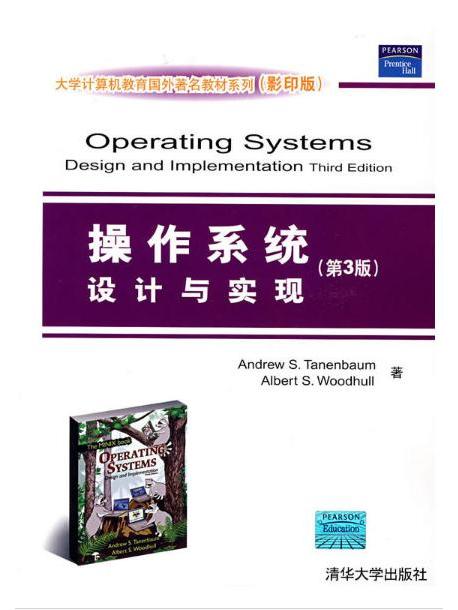基本介紹
- 中文名:作業系統設計與實現(第3版)
- 作者:Andrew S. Tanenbaum
- 出版時間:2008年5月4日
- 出版社:清華大學出版社
- ISBN:9787302172765
- 定價:69 元
- 裝幀:平裝

《作業系統設計與實現(第3版)》是2008年清華大學出版社出版的圖書,作者是Andrew S. Tanenbaum。圖書簡介本書是著名作者Andrew S. Tanenbaum關於作業系統的權威教材。多數作業系統的教材只...
《作業系統設計與實現(第三版)(上冊)》是2015年6月電子工業出版社出版的圖書,作者是陳渝、諶衛軍。內容簡介 本書是作業系統領域的權威教材之一。全書詳細介紹了作業系統的基本原理,包括進程、進程間通信、信號量、管程、訊息傳遞、...
《作業系統設計與實現(下冊)(第3版)》是關於作業系統的教材,詳細探討了作業系統的基本原理,包括進程、進程間通信、信號量、管程、訊息傳遞、調度算法、輸入/輸出、死鎖、設備驅動程式、存儲管理、調頁算法、檔案系統設計、安全和保護...
《計算機作業系統(第3版)》是由郁紅英、王磊、武磊、李春強編著,2018年清華大學出版社出版的21世紀高等學校計算機專業核心課程規劃教材。該教材的使用對象是開設作業系統課程的相關專業的本科生;具有一些作業系統基本知識並想進一步了解操作...
本書全面系統地介紹了現代計算機作業系統的基本理論和最新技術。全書共分為8章,第1章介紹了作業系統的概念、特徵和功能、發展歷史、結構和設計的相關問題,並介紹了常用的作業系統產品;第2章介紹了作業系統的生成與引導、向用戶提供的...
《作業系統設計與實現》是2007年3月電子工業出版社出版發行的圖書,作者是(美國)基夫爾。內容簡介 《作業系統設計與實現(OSP 2方法)》向學生展示了作業系統的許多重要特性,但同時又避免讓學生接觸底層的、與機器相關的問題。使用與《...
《FreeBSD作業系統設計與實現》是2006年人民郵電出版社出版的圖書,作者是(美)麥庫西克 。內容簡介 在這本經典著作里,兩位作者繼續就開放原始碼的FreeBSD的內部結構進行了全面、全新、權威的論述。他們高屋建瓴、簡明扼要地概括FreeBSD的...
《作業系統實用教程(第3版)實驗指導》通過Windows和Linux兩個作業系統各自的編程接口,提供一些編程實例,以此加深學生對作業系統設計原理的領會和對作業系統實現方法的理解,並且使學生在程式設計方面能夠得到基本的訓練。《作業系統實用教程...
層次式結構的計算機作業系統是為了減少以往作業系統中各個模組之間由於聯繫緊密而帶來的各種問題而誕生的,其可以最大程度的減少甚至是避免循環調用現象的發生,確保調用有序,為作業系統設計目標的實現奠定了堅實的基礎。在層次式結構的計算機...
《作業系統:原理與實現》是2023年機械工業出版社出版的圖書。內容簡介 作業系統目前已成為我國“卡脖子”的關鍵技術之一,這對作業系統的教材建設提出了新的要求。首先,教材需要體現作業系統的核心原理與設計,幫助讀者構築系統性的認識;...
《作業系統概念——Java實現》共有八大部分:第1章與第2章解釋作業系統是什麼、能做什麼以及它們是如何設計與構造的。第3章到第7章描述作為現代作業系統核心的進程以及並發的概念。第8章和第9章主要討論進程執行過程中的主存管理問題、...
該教材有配套教材——《Visual Basic程式設計(第3版)學習輔導》。教材特色 該教材以編寫VB應用程式為主線,把界面設計與程式代碼設計二者結合。每學完該教材的一章或一節,都能進一步掌握VB新的套用技能,在實現一個個具體任務的過程中...
9.3 高可靠嵌入式實時作業系統硬體基礎 9.3.1 80x86 9.3.2 powerpc 9.4 高可靠嵌入式實時作業系統的實現 9.4.1 概述 9.4.2 隔離保護 9.4.3 分區調度 9.4.4 分區間通信 9.4.5 健康監測 思考題 第10章 嵌入式系統...
《嵌入式作業系統設計與實現》是在本書是在《自己動手寫嵌入式作業系統》基礎上的的全面升級版,作者對自己親自在PC上開發的嵌入式作業系統的“HelloChina”進行全面的升級和改進,書中詳細地敘述自己動手寫嵌入式作業系統所需的各方面知識...
《4.4BSD作業系統設計與實現》是2012年1月1日機械工業出版社出版的圖書,作者是Marshall Kirk McKusick,譯者是李善平、劉文峰、馬天馳。內容簡介 《4.4BSD作業系統設計與實現》描述了4.4BSD的內部結構、概念、數據結構以及在實現4.4BSD...
《DSP實時多任務作業系統設計與實現》是2005 年11月電子工業出版社出版的圖書,作者是鄔可軍、朱銘鋯、曹建樹、張澤。內容簡介 本書以目前流行的tms320c2000系列數字處理器件和易於學習開發的dsp rtos嵌入式作業系統為核心,結合編者多年開發...
江紅,女,博士,華東師範大學數據科學與工程學院、計算機科學與軟體工程學院副教授,研究方向為現代信息系統及其開發技術。余青松,男,華東師範大學數據科學與工程學院、計算機科學與軟體工程學院計算中心高級工程師,研究方向為Web套用技術、...
《嵌入式作業系統原理與設計實現》是2023年6月1日清華大學出版社出版的圖書,作者:嚴海蓉、田銳。內容簡介 本書內容可分為兩大部分。第一部分(第1~10章)介紹了嵌入式作業系統原理。其中,第1章介紹嵌入式作業系統基礎知識; 第2章介紹...
《一個64位作業系統的設計與實現》是2018年人民郵電出版社出版的圖書,作者是田宇。內容簡介 本書講述了一個64位多核作業系統的自製過程。此作業系統自製過程是先從虛擬平台構築起一個基礎框架,隨後再將基礎框架移植到物理平台中進行升級...
4.4BSD作業系統設計與實現(中文版)《4.4BSD作業系統設計與實現(中文版)》是中國電力出版社出版的圖書,作者是麥庫斯克。
《作業系統:設計與實現(第二版)》是2003年12月1日電子工業出版社出版的圖書,作者是Albert S.Woodhull、Andrew S.Tanenbaum。內容介紹 本書共6章,涵蓋了作業系統課程的所有內容,即傳統上的進程管理、存儲器管理、檔案管理和設備...
《FreeBSD作業系統設計與實現(第2版) 英文版》是2019年9月人民郵電出版社出版的圖書,作者是Marshall Kirk McKusick George、V·Neville-Neil、Robert N·M·Watson。內容簡介 《FreeBSD作業系統設計與實現(第 2版)英文版》是迄今...
包括:C語言程式的結構,數據類型及基本運算量,結構化程式設計的順序結構、選擇結構、循環結構,數組及函式的開發方法與套用實現;第8~12章詳細介紹了C程式設計的高級套用,包括:編譯預處理、結構體、共用體、指針、檔案操作及位運算等...
6.3.2移動WebApp開發操作套用案例181 6.4軟體研發常用工具與環境184 6.4.1常用軟體研發工具和集成環境184 6.4.2常用的WebApp開發工具185 6.4.3編碼管理系統及編譯程式185 6.4.4軟體生成技術186 6.5軟體實現文檔187 6.5.1實現...
作業系統(設計及實現第2版影印版)《作業系統(設計及實現第2版影印版)》是清華大學出版社出版的圖書,作者是Andrew S.Tanenbaum、Albert S.Woodhull 。
